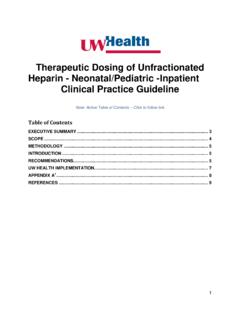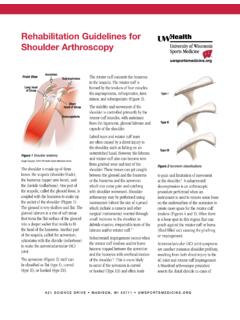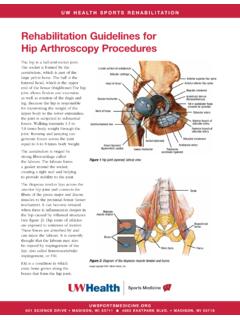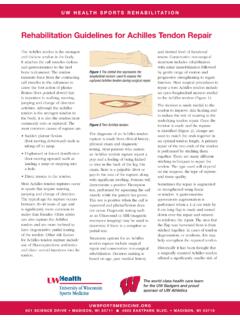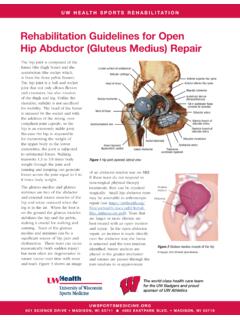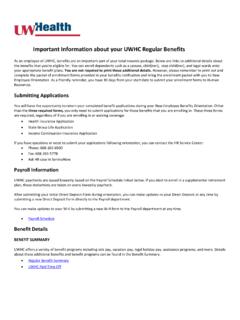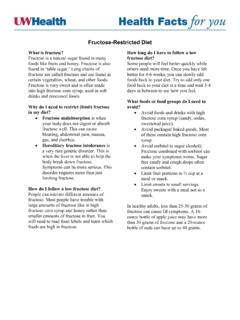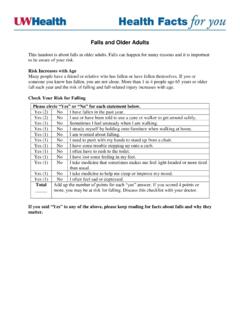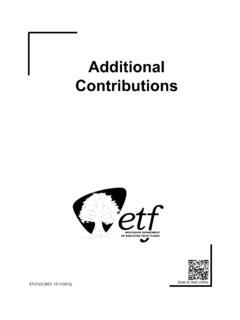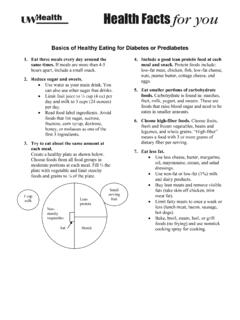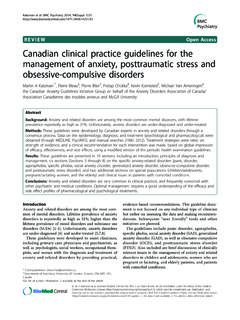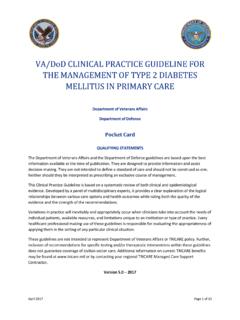Transcription of Warfarin Management - Adult - Ambulatory Clinical Practice ...
1 Warfarin Management - Adult - Ambulatory Clinical Practice Guideline Note: Active Table of Contents Click to follow link Table of Contents EXECUTIVE SUMMARY .. 3 SCOPE .. 4 METHODOLOGY .. 5 DEFINITIONS .. 5 INTRODUCTION .. 5 recommendations .. 5 UW HEALTH IMPLEMENTATION ..14 APPENDIX A ..16 REFERENCES ..15 CPG Contact for Content: Name: Anne Rose, PharmD - Pharmacy Phone Number: (608) 263-9738 Email Address: CPG Contact for Changes: Name: Philip Trapskin, PharmD, BCPS Drug Policy Program Phone Number: (608) 263-1328 Email Address: Guideline Author(s): Anne Rose, PharmD Anticoagulation Stewardship Program Coordinating Team Members: David Ciske, MD Anticoagulation Clinic/Internal Medicine Erin Robinson, PharmD, CACP Anticoagulation Clinic David Queoff, MD Family Medicine Review Individuals/Bodies: Teresa Darcy, MD Clinical Pathology Ambulatory Anticoagulation Committee Committee Approvals/Dates: UW Health Ambulatory Anticoagulation Committee: November 2010; June 2012; May 2013; September 2015 UW Health Pharmacy and Therapeutics: December 2010; July 2012; June 2013.
2 October 2015 Release Date: October 2015 | Next Review Date: October 2018 Executive Summary Guideline Overview This guideline outlines the evidence for managing anticoagulation therapy with oral vitamin K antagonist ( Warfarin ). Evidence is based on recommendations from the Antithrombotic Therapy and Prevention of Thrombosis, 9th edition: American College of Chest Physicians Clinical Practice guidelines . It provides recommendations for how to initiate, dose adjust and monitor Warfarin therapy in the Ambulatory setting. Key Practice recommendations 1. Initial Warfarin dosing should be tailored based on patient bleed risk, potential sensitivity to Warfarin , indication, goal INR range, and if potential drug interactions are present. 2. Maintenance Warfarin dose adjustments should be based on current INR results and trends and patient assessment of any missed doses, drug interactions, dietary intake or supplements, documentation of bleeding, or other changes that may affect the INR.
3 3. Table 5, 6 and 7 provide recommendations for Warfarin dosing for INR goals of , 2-3 and Companion Documents 1. Warfarin Management Adult Inpatient Clinical Practice Guideline 2. Atrial Fibrillation Adult Inpatient/ Ambulatory Clinical Practice Guideline 3. Antithrombotics in Non-Valvular Atrial Fibrillation Adult Inpatient/ Ambulatory Clinical Practice Guideline 4. HealthDecisionTM Atrial Fibrillation Risk Stratification Tool 5. Indications for Blood Product Transfusion Adult Inpatient/ Ambulatory Pertinent UW Health Policies & Procedures 1. UWHC Policy # Anticoagulation Monitoring by UW Anticoagulation Clinic Pharmacists 2. UW Health Policy # Entering Test Results into UW Health Link (EPIC) Patient Resources 1. Health Facts For You #6900: Warfarin (Coumadin, Jantoven) 2. Health Facts For You #322: Food-Drug Interactions: Coumadin & Warfarin Diet Interactions 3.
4 Health Facts For You #6915: Heparin (Unfractionated and Low Molecular Weight) 4. Health Facts For You #6115: Stopping Anticoagulation and Antiplatelet Therapy Scope Disease/Condition(s): This guideline will apply to any disease or condition requiring anticoagulation with oral vitamin K antagonist ( Warfarin ) therapy Clinical Specialty: Internal Medicine Family Practice Cardiology Hematology Pharmacy Nursing Intended Users: Physicians Advanced Practice Providers Pharmacists Nurses Objective(s): To provide a strategy for the Management of Warfarin therapy in Ambulatory Adult patients using a standardized process while offering an individualized assessment. Target Population: Adult patients being initiated and maintained on Warfarin therapy in the clinic setting. Interventions and practices Considered: This guideline provides strategies and recommendations designed to assist clinicians in developing Warfarin Management plans.
5 It begins with providing recommendations for target INR ranges based on indication for use. It focuses on how to dose Warfarin based on individual patient risk factors, INR response, drug interactions, and dietary interactions. Major Outcomes Considered: Thromboembolic events while initiating and maintaining Warfarin therapy Hemorrhagic events while initiating and maintaining Warfarin therapy Need for reversal agents in the event of a bleeding event or emergent surgery/procedure. Guideline Metrics: Metrics will include time within target INR range, sub and supratherapeutic INR values, critical INR values, appropriate dose adjustments based on drug and dietary interactions while receiving Warfarin therapy. Methodology Methods Used to Collect/Select the Evidence: (1) completing a comprehensive literature search of electronic databases; (2) conducting an in-depth review of relevant abstracts and articles; (3) conducting thoughtful discussion and interpretation of findings; (4) ranking strength of evidence underlying the current recommendations that are made.
6 Methods Used to Assess the Quality and Strength of the Evidence: A similar grading system for the recommendations from the American College of Chest Physicians was utilized. Rating Scheme for the Strength of the Evidence: For all other recommendations a modified Grading of recommendations Assessment, Development and Evaluation (GRADE) developed by the American Heart Association and American College of Cardiology (Figure 1.) has been used to assess the Quality and Strength of the Evidence in this Clinical Practice Definitions 1. Baseline INR an INR resulted within the previous 30 days prior to initiating Warfarin 2. Current INR an INR reported on the same calendar date as the scheduled Warfarin dose Introduction This guideline outlines the evidence for managing anticoagulation therapy with oral vitamin K antagonist ( Warfarin ).
7 For dosing and monitoring of Warfarin therapy it is recommended that standardized and validated decision support tools be used for most patients. Evidence has shown improved time in therapeutic INR range and Clinical outcomes in patients managed by trained staff using standardized procedures and dosing decision support Warfarin works by inhibiting the reduction of vitamin K epoxide and limiting the activation of vitamin K dependant clotting factors: II, VII, IX and X. It also inhibits the synthesis of anticoagulant proteins C, S and Z. When administered orally Warfarin is rapidly and completely absorbed. It is highly protein bound and metabolized by the cytochrome P450 (CYP) enzyme 2C9, 1A2 and 3A4. The half-life of Warfarin is 36-42 This guideline provides recommendations that are based on the evidence outlined from the Antithrombotic Therapy and Prevention of Thrombosis 9th edition: American College of Chest Physicians Clinical Practice guidelines (CHEST).
8 2-8 recommendations 1. INR goals and duration of therapy listed in Table 1 are recommended by the CHEST (Class I, Level B) Exceptions include orthopedic surgery INR goals which are recommendations provided by UW Health Orthopedic surgeon consensus and based on the American Association of Orthopedic Surgeons Clinical guideline on Prevention of Symptomatic Pulmonary Embolism in Patients Undergoing Total Hip or Knee Arthroplasty9 (Class IIb, Level C) Alternative INR goals may be chosen for specific patients when bleeding risk outweighs clotting risk and will be determined by the individual s provider (Class IIb, Level C) Table 1. Indications for Antithrombotics, INR Ranges, and Duration of Therapy2-10 Indication INR (Range) Duration Comments Thrombophilia with Thromboembolic Event2 Antiphospholipid Syndrome (2-3) Chronic Homozygous Factor V Leiden (2-3) Chronic Deficiency of Protein C, S or Anti-Thrombin (2-3) Chronic Atrial Fibrillation (AF)/ Atrial Flutter4 CHA2DS2 VASc = 0; Low stroke risk None May choose aspirin 75-325 mg daily CHA2DS2 VASc 1.
9 Intermediate/High stroke risk (2-3) Chronic Anticoagulation CI: aspirin 75-325 mg and clopidogrel 75 mg daily Pre-cardioversion (AF or flutter >48 hours) (2-3) 3 weeks Post-cardioversion (in NSR) (2-3) 4 weeks Ischemic Stroke5 Non-cardioembolic stroke or TIA None Chronic Use antiplatelet therapy Cardioembolic stroke or TIA -With Warfarin CI None Chronic Aspirin 81-325 mg daily -With cerebral venous sinus thrombosis (2-3) 3-6 months - With patent foramen ovale None Chronic Use antiplatelet therapy Thromboembolism (DVT, PE) symptomatic or asymptomatic6 Provoked VTE event (2-3) 3 months Unprovoked: 1st VTE event - Proximal or Distal DVT (2-3) 3 months After 3 months evaluate risk-benefit for extended therapy - PE (2-3) > 3 months After 3 months evaluate risk-benefit for extended therapy Unprovoked.
10 2nd VTE event - DVT or PE (2-3) > 3 months Consider chronic With malignancy (2-3) > 3 months LMWH preferred over Warfarin Consider chronic Acute Upper Extremity DVT - Associated with central venous catheter that was removed (2-3) 3 months - Associated with central venous catheter that was NOT removed (2-3) Extended Continue anticoagulation until catheter removed - Not associated with a central venous catheter (2-3) 3 months Spontaneous superficial vein thrombosis None 45 days Prophylaxis LMWH or Fondaparinux Valvular Disease7 Rheumatic mitral valve disease - Left atrial diameter < 55 mm None - With AF, left atrial thrombus, or left atrial diameter > 55 mm (2-3) Chronic Valve Repair Aortic None Aspirin 81 mg daily Mitral None 3 months Antiplatelet therapy Valve Replacement - Bioprosthetic Aortic or TAVI* None Antiplatelet therapy Mitral (2-3) 3 months Followed by aspirin 81 mg daily * If other indication for anticoagulation exist see specific indication for therapy recommendations Valve Replacement - Mechanical Aortic (2-3) Chronic Low bleed risk: add aspirin 81 mg Mitral 3 ( ) Chronic Low bleed risk: add aspirin 81 mg Dual Aortic and Mitral Valve 3 ( ) Chronic Low bleed risk.
